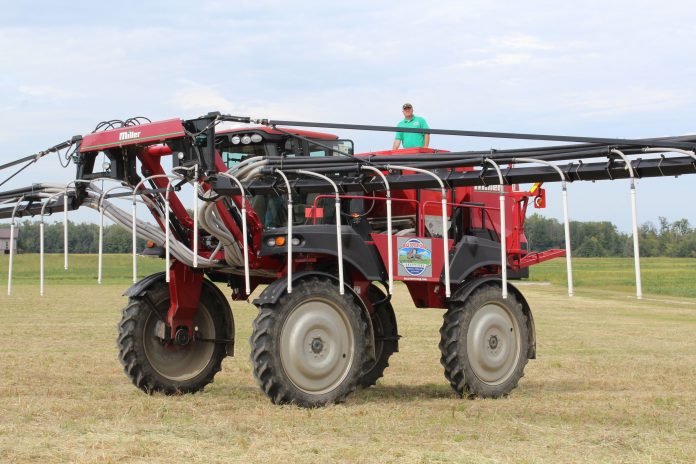It is almost time to put seed in the ground. Whether you have been no-till planting for years or trying it for the first time, here are some things to check before the planter leaves the shop.

1Meters
No-till planting meters should be tested every 1 or 2 years or every 300 to 400 acres. Change belts and brushes every 3 to 4 years.
2Planter hitch position
If the hitch is too low and tipping unevenly front to back, it causes the seed tube to angle forward and could result in seed flying out the seed tube instead of gently dropping into the furrow. The hitch should be set so the planter’s toolbar is level to even slightly higher front to back. This ensures proper seed drop and accurate seed placement into the furrow.
3Depth of coulters
No-till coulters should be 1/4 inch shallower than the disc opening. A good test is to set the planter disc openers on a board; the coulters should spin freely.
4Disc openers
Disc openers should be measured; if the opening is 1/2 inch or smaller, they should be replaced. Disc openers that are worn can cause a “W” instead of a clean “V” trench. Business cards can be used to check adequate spacing, one from the top of the blade and one from the bottom of the blade.
The space between the blades should be 1 3/4 inches for 3.5 mm blades and 2 1/2 to 3 inches for 3.0 mm blades. Worn or incorrect settings can cause uneven seed depth.
5Seed tubes
No-till seed tubes should not have any play left to right. Tubes should be replaced annually, and even new seed tubes should be checked to make sure they are smooth inside. Any irregularities from the molded plastic should be filed down to prevent seed ricocheting in various directions as it leaves the tube. Check to make sure the bottom isn’t frazzled or broken and that the hook, which is halfway up the tube, is not broken.
6Chains
Chains should be snug. Check spring tension. With planter raised completely, chain should be as short as possible. Spring should not be stretched out. Check all chain idlers and bushings. Replace if worn. Oil all chains and grease zerks.
Next week: Check back next week for more no-till planting prep tips.
Source: Pennsylvania No-Till Alliance, No-Till Tips, A quick reference guide for the no-till farmer.
(Farm and Dairy is featuring a series of “101” columns throughout the year to help young and beginning farmers master farm living. From finances to management to machinery repair and animal care, farmers do it all.)
More Farming 101 columns:
- 7 considerations for gardening with high tunnels
- 9 basic considerations for backyard poultry
- 9 ways to grow your farm business
- 10 questions to ask before expanding the farm
- How to select quality replacement heifers
- Stay safe working with electricity on the farm
- How to create a job safety analysis
- Tips for a successful lambing season
- Do you have a vision for your farm?
- Cattle handling for beginners
- Should I buy a new or used tractor?
- How to inspect a used tractor before purchase
- How to buy the right tractor for your farm
- 5 tips for a better farm marketing plan
- How to seek help with retirement planning
- How to set goals for retirement
- A farmer’s guide to saving for retirement
- A farmer’s guide to planning for retirement
- 5 steps to get NRCS assistance
- How can conservation easements help you?
- How to fund conservation plans
- What is a conservation plan?
- How can NRCS help you?
- More airborne hazards on the farm
- 5 airborne hazards to beware of on the farm
- 5 things to know about Wagyu beef
- Pennsylvania utility vehicle laws
- Ohio utility vehicle laws
- Farm chemical safety checklist
- When should a farm become a business entity?
- Harvest prep: Check your yield monitors
- How to tag livestock properly
- 6 tips for decision making on a family farm
- 8 tips to prepare your farm for agritourism
- How to plan for farm emergencies
- 7 keys to success on the farm
- 7 tips for healthy fair animals
- 5 tips to ensure livestock health before the fair
- 6 tips to keep your livestock parasite free
- 6 tips for vaccinating your livestock
- 5 tips to prevent dairy cow foot problems
- 6 common foot problems found in dairy cows
- Recognize, prevent heat stress in dairy cattle
- How to monitor your dairy herd
- How to start your own dairy farm
- 5 tips for sun safety in the field
- Employing youth for the summer
- What to do if a hay fire occurs
- How to prevent hay fires
- How to extend the life of your fence
- 10 safety tips for installing electric fences
- How to chose the right fence for your farm
- How to create a fencing plan
- 7 steps for easy sprayer calibration
- Prepare for planting season, Part 2: Calibration
- Prepare for planting season, Part 1: The Basics
- 7 tips to improve security on your farm
- 5 tips to protect your farmland
- 3 measures to deal with severe farm debt
- How to buy time to catch up on farm debt
- 6 tips to manage income on the farm
- 5 tips to recognize and deal with farm stress
- How to prepare a livestock birthing kit
- 5 tips for marketing your farm
- How to develop farm mission, vision statements
- 5 tips for setting farm goals
- 2 types of livestock insurance policies
- 6 things you need to know about WFRP plans
- 3 basics of crop insurance
- How does liability insurance work on the farm?
- Why do I need farm insurance?
- How to understand and use Ohio’s CAUV
- How to utilize the Pa. Clean and Green Act
- 9 tips for filing farm taxes
- 8 reasons record keeping for taxes is essential
- 5 tips for post-harvest storage
- 7 tips for family meetings on the farm
- 4 tips for balancing your farm and family
- 4 tips for communicating on the family farm
- 4 tips for firing an employee
- 6 tips for keeping good farm help
- 4 tips for recruiting farm labor
- 5 general farm labor laws
- 4 tips for employing minors
- 4 tips for PTO safety
- 5 things young farmers should know about finances
- The farm balance sheet
- 5 items for your farm’s cash flow statement
- Personal and business records: Keep them separate
- What to include in your farm business plan
- How to approach a lender: Tips for getting a farm loan
- How to use microloans to get your farm started
- Saving for the future: 6 tips for young farmers
- How to create a farm safety kit
- 5 tips for child safety on the farm
- 4 tips for transporting livestock
- 5 ways to better understand tractor stability
- 6 farm equipment hacks










